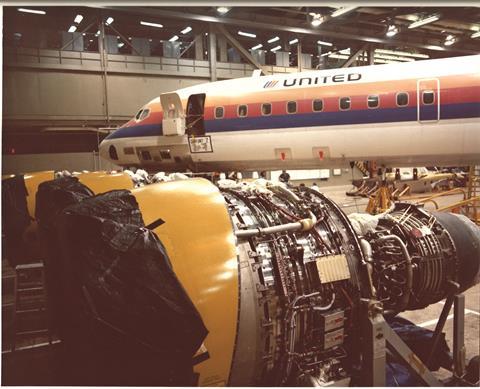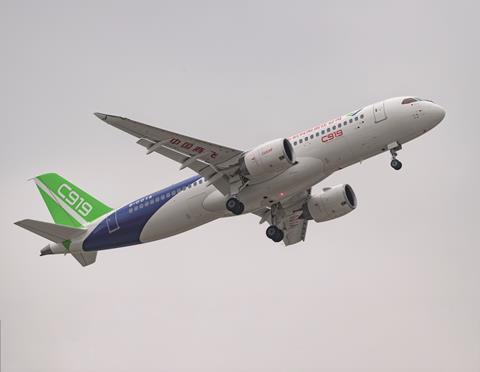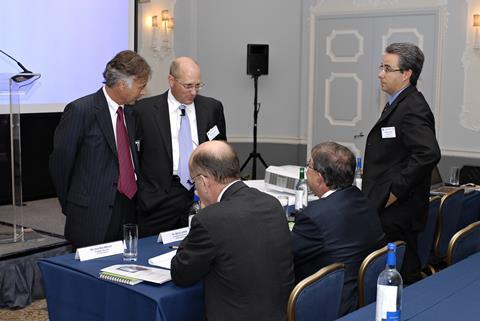How an unlikely partnership that needed presidential intervention to get off the ground and almost collapsed five years later went on to become the most successful ever jet engine manufacturer
The second year of the seventies saw Disney World open in Florida, Norway launch North Sea oil production, and Apollo 15 astronauts ride a buggy on the Moon. It was also when two brilliant engineers – both Second World War heroes and respective heads of Snecma and General Electric’s aero engines business – convened in a former hunting inn in Barbizon, France to lay the ground for an audacious transatlantic marriage.
![]()
Three years later that framework – sketched out over several days by René Ravaud and Gerhard Neumann and their teams at their Auberge du Bas Bréau retreat on the edge of Fontainebleau Forest near Paris – legally became the 50/50 joint venture CFM International, the most successful jet engine company in history. It marked its 50th anniversary on 24 September 2024.
The Barbizon summit – days after Neumann and Ravaud met for the first time at the Paris air show – may have been CFM’s conception, but GE and Snecma had been making eyes for a while. Since the late 1960s, the French company had been producing parts for the CF6-50, the Airbus A300 engine, and a deeper partnership had been on the agenda when executives from both businesses sat down for exploratory talks in Boston’s Ritz-Carlton in 1970.
At first glance, the two entities had little in common culturally. One was a state-owned champion forged by a post-war government keen to restore France’s status as a global industrial and military power. The other was a Wall Street industrial behemoth, with interests in everything from locomotives to light bulbs. Their people spoke different languages, used different currencies, and had very different ways of looking at the world.
However, both companies – each a military contractor of repute – shared one big ambition. They wanted to break into a commercial market dominated by Pratt & Whitney and, to a lesser extent, Rolls-Royce, and sensed a particular opportunity in the emerging short- to medium-haul segment served by the likes of the all-new Boeing 737.
Snecma had been developing a 10-tonne or 20,000lb (89kN)-thrust, high-bypass engine called the M56 it believed could vastly improve on the reliability, fuel efficiency, and noise performance of older-generation types that dominated the market. However, Ravaud rightly understood that he needed an established partner to share risk, finesse the technology, and add manufacturing heft, a view shared by the French government.
The French company had a good relationship with the other two engine giants: it had been producing P&W’s JT8D under licence and the world’s biggest manufacturer of commercial engines at the time was, in many ways, the obvious choice for a transatlantic tie-up. Meanwhile, Snecma and Rolls-Royce had collaborated on the Olympus engine for Concorde, which had its maiden flight in 1969.
Both options were rejected in favour of GE. Ravaud and his colleagues believed that the US firm was at the right stage of its product development cycle in this promising new segment. P&W was determined to stick with its older generation JT8D, and Rolls-Royce was in crisis after being taken into state hands following its 1971 bankruptcy. What is more, GE’s management seemed more amenable to working closely with the French company.
By the end of 1971, both parties were committed to the creation of CFM International and the development of the CFM56 (the designation is an amalgam of GE’s CF engine family name and M56, the prototype Snecma product). However, the joint venture still had to surmount enormous political and commercial obstacles before – as well as for several years after – it came into being.
Firstly, came opposition from a US Department of Defense worried about critical core technologies GE would bring to the project (the same as those used for the Rockwell B-1 bomber’s F101) falling into Russian hands. That impasse needed the intervention of President Richard Nixon, with a historic agreement signed in Iceland with his counterpart Georges Pompidou in May 1973 giving the green light to CFM International’s foundation.
But there were even bigger headaches to come. Despite glowing reviews in the aerospace media and successful ground and flight tests – the CFM56 demonstrator had its first test bench run in June 1974 – for almost the entire rest of the decade the CFM56 remained an engine with no platform. The 737 already had the JT8D and there were no signs of anyone entering the market (Airbus would not launch the A320 until 1984).
However, in 1979 – five years after the venture’s formation and two years after the CFM56’s first flight – came a surprise breakthrough. With the programme burning funds from its parent companies and weeks from being shelved, Delta Air Lines, United Airlines and Flying Tigers – a scheduled cargo airline – selected the CFM56-2 to re-engine DC-8 aircraft. Soon after, the US Air Force chose the CFM56 to re-power its Boeing KC-135 tankers.

The re-engining agreements may not have been the all-new platform application the joint venture’s founding fathers had hoped for, but it bought the programme time – time that allowed CFM International to win its most important deal, one that secured the future of the company. In November 1980, Boeing agreed to let CFM design an exclusive variant of the CFM56 for a second generation 737, the -300.
That was followed a few months later by a launch order for 10 CFM56-3-powered 737-300s, from USAir, and shortly after by another commitment from a brash low-cost carrier in Dallas called Southwest Airlines, determined to take advantage of a newly deregulated US airline sector that would allow it to expand beyond the borders of Texas. The CFM56-3 made its first revenue flights with both operators in December 1984.

By the standards of what was to come in the following decades, CFM’s market success was still modest. However, in the space of a few years both parent companies had shifted from almost losing patience with the project to having rapidly to scale up final assembly lines, workforces, and supply chains on both sides of the ocean to meet a mounting backlog of engine orders.
The programme’s prospects were enhanced further when Airbus launched its first narrowbody twinjet, the A320, with another variant of the engine, the CFM56-5. Although the International Aero Engines V2500 was also available as a power option on the type, it gave CFM a place on what would become the two dominant single-aisle families over the next several decades.
In the early 1990s, CFM’s reputation grew again when Boeing chose the CFM56-7B as the exclusive engine for its Next-Generation 737. The variant entered service with a now fast expanding Southwest in 1998. Meanwhile, CFM had developed an improved version of its A320 engine, with the CFM56-5B going into operation with Alitalia in 1995.
The decade closed with the ten thousandth CFM56 being delivered at the 1999 Paris air show: in reality, two engines were ceremonially handed over: a CFM56-5B for Airbus and a CFM56-7B for Boeing. As the new century began, and with an agreement in place between GE and Snecma to continue the joint venture until at least 2013, CFM was well on its way to becoming the industry’s most prolific engine manufacturer.
While this century saw CFM further consolidate its market leadership, it has also marked the joint venture’s transition from a single-product manufacturer (albeit a CFM56 with several versions). The first sign of CFM’s intention to develop a CFM56 successor came in 2004, with the CFM56 Tech Insertion programme leading to a series of upgrades to the Boeing and Airbus variants, and the resulting CFM56-7BE and CFM56-5B PIP.
The following year saw a more significant move with the launch of the LEAP56 technology development programme, designed to future-proof CFM for the next 30 years and beyond. In July 2008, CFM formally launched the LEAP-X engine for next-generation aircraft at the Farnborough air show. Like the CFM56 three decades earlier, it remained, for now, an engine without an application. However, unlike the CFM56, it did not have long to wait.
The first aircraft manufacturer to select the LEAP engine was neither Boeing nor Airbus, but China’s COMAC, which, in December 2009, opted for the LEAP-1C engine as the solo powerplant for its in-development 150-passenger C919. While no one expected the debutant Chinese narrowbody to outsell its US and European rivals, CFM’s first deal with a non-Western manufacturer, and for a new engine to boot, was momentous.

The next two years saw the joint venture’s traditional airframer partners come on board, with Airbus selecting the LEAP-1A as one of two engine options on its A320neo, and Boeing launching the exclusively LEAP-1B-powered 737 MAX with a commitment from American Airlines. The initial letters of the three aircraft manufacturers gave CFM neat -1A, -1B, and -1C designations for the trio of variants.
With a new decade underway and CFM56 orders still pouring in, both partners started preparing for parallel assembly of the LEAP, which began ground testing in 2013 and flight testing a year later. In 2016, CFM’s first all-new engine since the 1970s entered service, powering a Pegasus Airlines A320neo. By 2024, LEAP engines were powering more than 3,500 airliners, with the fleet having logged more than 60 million flight hours.
CFM’s next departure was even more radical. In June 2021, GE Aerospace and Safran (which the French company had become in 2005 after its merger with Sagem) launched RISE – or Revolutionary Innovation for Sustainable Engines – a project to demonstrate a series of technologies, including an Open Fan architecture, aimed at delivering a 20% improvement in fuel consumption and CO2 emissions for a new generation of aircraft.

At the same time, the two businesses signed a new agreement to take the CFM International partnership to 2050 (they had already committed to 2040 at the time of the LEAP engine launch in 2008). This date fittingly coincides with the industry’s target of halving CO2 emissions as well as the approximate timescale for an all-new CFM engine that goes into service around a decade from now reaching maturity.
The technological challenges of the RISE project have led to engineers from GE Aerospace and Safran Aircraft Engines collaborating more closely than ever, in areas such as carbon fiber fan blades and ceramic matrix composites, and in fully understanding the potential – and possible limitations – of an Open Fan design. Get the decisions right over the next few years and CFM will be even more firmly in the vanguard of the industry’s shift to a sustainable future.
Half a century from the signing ceremony that gave birth to this most innovative and productive propulsion partnership there is still plenty CFM history to be written.
CFM International at 50
- 1
- 2
- 3
 Currently reading
Currently readingCFM International at 50: The start of something big:
- 4
- 5
- 6
- 7
- 8
- 9
- 10


















































